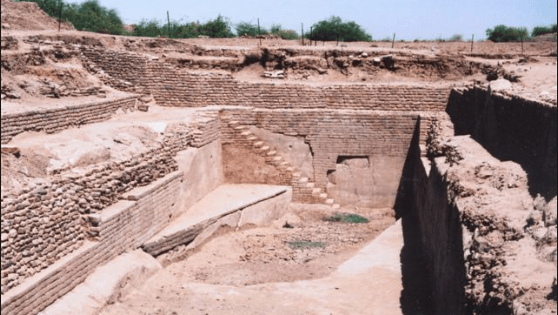According to the syllabus released by the UPSC, Indus valley civilization is a crucial topic under ancient Indian history for the CSEs. In this post, we will cover all major aspects of the Indus valley civilization all through its origin till decline.
- About Indus Valley Civilization
- Indus Valley Civilization Notes for UPSC
- Salient Features of Indus Valley Civilization
- Important Sites Of Indus Valley Civilization
- Reasons for Decline of the Indus Valley Civilization
About Indus Valley Civilization
The origin of the Indus valley civilization is debatable, but a majority of researchers have credibly traced it back to Mehrgarh in the Neolithic period.
In the present day, Mehrgarh is located close to the Bolan Pass alongside the Kacchi Plain in Baluchistan.
The site being located on the valleys of the river Indus led to it being called the Indus Valley Civilization.
Indus Valley Civilization Notes for UPSC
Let’s quickly overview the following pointers:
- The civilization dates back to around 3300 BC.
- It is interchangeably also referred to as the Harappan civilization, due to its association with Harappa which was the first city to be discovered in Punjab, Pakistan.
- The golden age of the civilization is estimated to fall between 2700 BC and 1900 BC, which we can also call as the mature Indus valley civilization (800 years).
- As per researchers, the downfall of this great civilization started around 1900 BC. By 1400 BC, there were hardly any traces of them left behind.
- On the map, the civilization geographically can be identified as the following :
- It was spread over the regions of Baluchistan, Punjab, Sindh, Rajasthan, Gujarat, and western Uttar Pradesh.
- Started from Sutkagengor (Baluchistan) in the west all the way to Alamgirpur (western Uttar Pradesh) in the east
- In the north, from Mandu (Jammu) to Daimabad (Ahmednagar, Maharashtra) in the south.
- Few traces of the civilization have also been found in parts of Turkmenistan and Afghanistan.
Salient Features of Indus Valley Civilization
- The Indus valley civilization or Harappan civilization marked the start of cities planned for living.
- The discovery of Harappa is credited to Dayaram Sahni, Madho Sarup Vats and Marshall In 1921; While Mohenjodaro is credited to R.D.Banerji, Marshall and E. J. H. Mackay.
- The standout feature was the use of own seals. Although discovered by J fleet long back, their script has not yet been understood completely
- The second prominent aspect of the valley is their impeccable city planning. The cities were well laid out and constructed. It was systematically divided into the west (citadel) and east (lower town)
- The cities had a systematic design of roads
- They had an efficient drainage system in place
- Sun-Dried or baked bricks were used for construction
- The houses were well equipped with water reservoirs/tanks/wells, and a kitchen.
- They had a foolproof wastewater management system.
- Stone weights found to suggest a system of standard measurement and weight.
- Studies show the use of silver, copper, bronze, and gold. They also worked with lead and tin. Iron was not used.
- They used sophisticated tools for their time, including man-made tools of copper, long stone blades, etc.
- Male and female deities were worshipped although there is no proof of any temple or related structures. The famous “Pashupati seal” discovered portrays a three-eyed figure that is suggested to be Lord Shiva.
- They were experts in the artwork. Famous artworks discovered from Mohenjo-Daro include the “dancing girl” statuette and a bearded priest king figurine.
- There is evidence of wheel-made pottery. Red pottery that’s hand-painted with black designs has been found.
- Ornaments and objects like beads, vessels, earrings, and bangles created by faience techniques have been discovered. Faience is a term used to denote beads, figurines, ornaments and other trinkets made from glazed ceramic.
- They were specialists in handicrafts.
- They practiced burying their dead. While they were initially put into wooden coffins, as the cemetery H culture evolved, the bodies were cremated in painted burial urns.
- There was an import of raw materials. They traded with the Sumerians.
- They practiced agriculture extensively. It is the first civilization to practice cotton cultivation.
- Animals were reared including goats, pigs, and sheep.
- Evidence of plough being used has been observed in the valley site. Peas, ragi, barley, wheat, and dates were produced.
Important Sites Of Indus Valley Civilization
The major sites discovered belonging to the Indus Valley Civilization can be categorized based on the following two countries: –
1. In India
- Ropar in Punjab
- Kalibangan in Rajasthan
- Surkotda, Rangpur, Lothal, and Dholavira in Gujarat
- Banawali in Haryana
2. In Pakistan
- Mohenjo-Daro on the banks of the river Indus (sindh)
- Chanhudaro in Sindh
- Harappa on the banks of river Ravi
Reasons for Decline of the Indus Valley Civilization
The exact reasons for the disappearance of this once flourishing civilization has yet not been discovered. Research suggests a slow process of continuous depreciation that ultimately led to its end.
Let us understand the multiple factors that have led to its extinction: –
- The cities were slowly abandoned, as the residents started moving eastwards.
- Although once British archaeologist Sir Mortimer Wheeler had linked its disappearance to the Aryan invasion, modern archaeologists have since then successfully debunked the theory.
- As per the English philanthropist Robert Raikes, the city was swept out of history due to floods and movement of tectonic plates.
- British archaeologist, Hugh Trevor Lambrick advocated the change in course of the Indus River as the main cause behind the valley’s extinction.
- Researchers now conclude that several factors were at work and not just one.
- Other reasons suggested include – gradual deforestation, flooding of few cities, a decrease of greenery and drying up of rivers.





